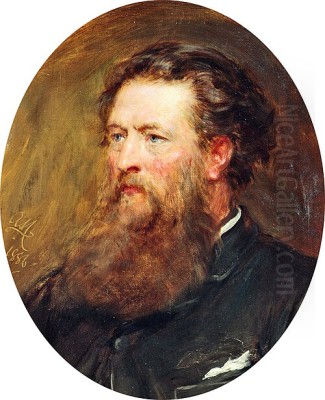
George Vicat Cole stands as one of the most popular and successful English landscape painters of the later Victorian era. Born on April 17, 1833, in Portsmouth, England, and passing away on April 6, 1893, in London, Cole dedicated his artistic life to capturing the quintessential beauty and tranquil atmosphere of the English countryside. His work, deeply rooted in the tradition of British landscape art, resonated strongly with the public, earning him significant recognition and a lasting place in the annals of art history. He became particularly renowned for his depictions of Surrey, Sussex, and the Thames Valley, rendered with a characteristic sensitivity to light and natural detail.
Early Life and Artistic Formation
Artistry was in George Vicat Cole's blood. He was the eldest son of the established landscape painter George Cole (1810–1883), a largely self-taught but successful artist known for his animal and landscape subjects. The elder Cole provided his son with his initial artistic training, fostering his burgeoning talent from a young age. George Vicat Cole's mother, Eliza Vicat, hailed from a family of French Huguenot descent, adding another layer to his heritage. Growing up in an artistic household meant that painting was a constant presence, and the young Vicat Cole quickly absorbed the fundamentals under his father's guidance.
His formal education in art was primarily practical, learning directly from his father and through the close observation of nature. He accompanied his father on numerous sketching expeditions, including trips through the scenic Moselle Valley in France and various parts of southern England and Wales. This early exposure to working directly from the landscape, or en plein air, profoundly shaped his artistic approach. He also honed his skills by studying and copying the works of earlier masters of British landscape, notably J.M.W. Turner and David Cox, whose handling of light and atmosphere left a discernible mark on his developing style.
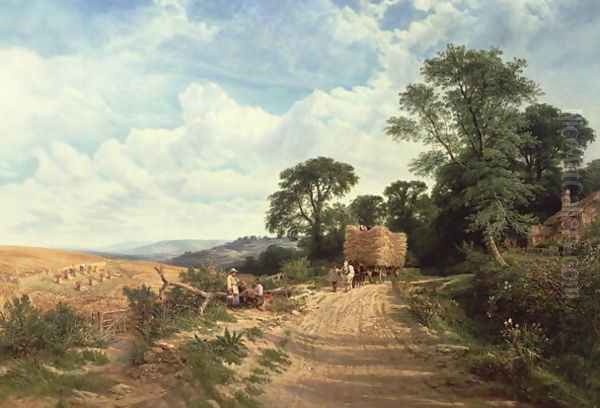
By the age of nineteen, George Vicat Cole was already exhibiting his work professionally. His debut was not at the prestigious Royal Academy, but at the British Institution in 1852. This marked the beginning of a public career that would span four decades. His early works naturally showed the strong influence of his father, George Cole, but even then, hints of an independent artistic vision were beginning to emerge, particularly in his treatment of light and his choice of specific, identifiable locations.
The Emergence of a Distinct Style
While George Vicat Cole inherited a solid foundation from his father, he soon developed his own unique artistic voice. His style is best characterized as naturalistic, focusing on the faithful representation of the English landscape. He was less interested in the dramatic or sublime aspects of nature that captivated Turner, or the highly romanticized visions of some earlier painters. Instead, Cole sought to capture the gentle, pastoral beauty of the home counties, particularly the lush fields, meandering rivers, and wooded areas of Surrey and Sussex.
A key element of his style was his exceptional sensitivity to light and atmosphere. Cole masterfully depicted the changing effects of sunlight throughout the day – the golden glow of late afternoon, the crisp light of morning, or the hazy softness of a summer day. His paintings often convey a palpable sense of time and weather. This focus on atmospheric effects aligns him with the broader trends in 19th-century landscape painting, influenced by John Constable's commitment to capturing the transient moments of nature.
Cole's technique was often described as straightforward and direct, yet highly effective. He built up his canvases with careful attention to detail, particularly in the rendering of foliage, water, and agricultural elements like haystacks or harvested fields. While detailed, his work generally avoided the microscopic precision associated with the Pre-Raphaelite Brotherhood, though he shared their commitment to truthfulness to nature. Indeed, some critics noted an affinity with Pre-Raphaelite principles in his dedication to outdoor observation and bright, naturalistic colour palettes, particularly in his earlier career. The influential Pre-Raphaelite painter Sir John Everett Millais was an early admirer and supporter of Cole's work.
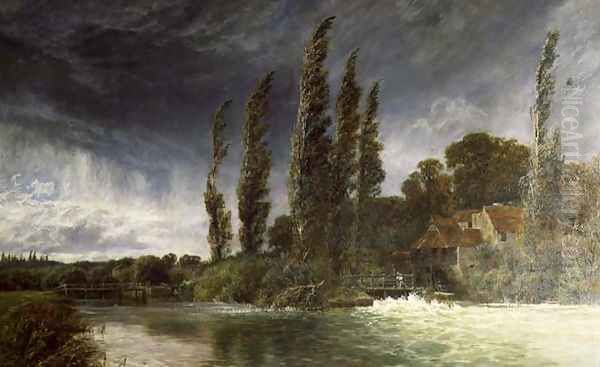
His subject matter remained consistently focused on the English landscape. Unlike artists who travelled extensively seeking exotic locales, Cole found endless inspiration in the familiar scenery around him. The River Thames, in particular, became a recurring motif, depicted in its various moods from tranquil rural stretches to the bustling Pool of London. Harvest scenes were another favourite theme, allowing him to explore the rich colours and textures of the agricultural cycle and evoke a sense of timeless rural life that held great appeal for Victorian audiences.
Building a Career: Exhibitions and Recognition
George Vicat Cole's professional journey began with promise but also faced early challenges. Despite his talent and connections, the art market could be precarious. In the early 1850s, his paintings sometimes sold for very modest sums, reportedly as low as around 40 shillings (or £2). However, his persistence and growing skill soon brought greater rewards. His debut at the Royal Academy of Arts Summer Exhibition came in 1853, marking a significant step into the mainstream art world.
A brief period of personal difficulty arose around 1855 when disagreements led to a rift with his father, causing Vicat Cole to move out of the family home. Despite this, his career continued its upward trajectory. He became a member of the Society of British Artists (SBA) in 1858, exhibiting regularly at their Suffolk Street galleries until 1864. Membership in such societies provided valuable exhibition opportunities and connections within the London art scene.
The Royal Academy remained the most important venue for establishing an artist's reputation in Victorian Britain. Cole exhibited there consistently throughout his career, gradually building his standing. His dedication paid off when he was elected an Associate of the Royal Academy (ARA) in 1870. This was a significant honour, recognizing him as one of the country's leading artists. Ten years later, in 1880, he achieved the highest rank, being elected a full Royal Academician (RA). This prestigious title cemented his position within the art establishment.
His popularity with the public grew steadily. His accessible, beautifully rendered landscapes struck a chord with Victorian tastes, offering idyllic yet believable visions of the English countryside at a time of rapid industrialization and urban growth. His works were sought after by collectors, and engravings of his paintings further broadened his reach. His success allowed him to live comfortably and maintain a studio in Kensington, a fashionable London neighbourhood favoured by artists.
Favourite Haunts: Subject Matter and Locations
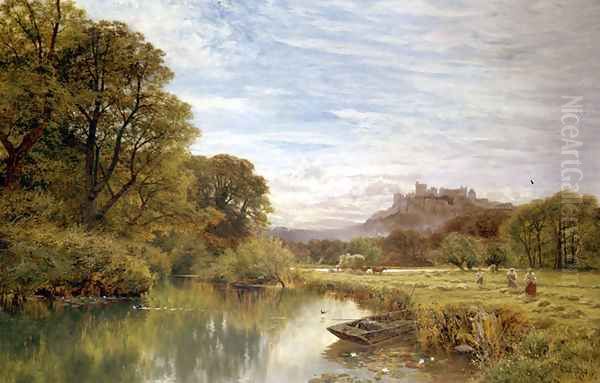
George Vicat Cole's heart belonged to the landscapes of Southern England. While he undertook sketching trips elsewhere early in his career, the counties of Surrey and Sussex, along with the Thames Valley, became his primary artistic territory. He developed an intimate knowledge of these areas, returning to favourite spots repeatedly to capture them under different conditions of light and season.
Surrey, with its rolling hills, picturesque villages, and abundant woodlands, provided endless inspiration. He painted scenes around Abinger, Holmbury Hill, and Leith Hill, often focusing on pathways through woods, sun-dappled fields, and panoramic views. These works captured the quiet charm and gentle beauty of the Surrey countryside, appealing to a public increasingly drawn to rural retreats and the perceived virtues of country life.
The River Thames was arguably his most beloved subject. He painted numerous views along its course, from the upper reaches near Oxford, featuring works like Iffley Mill, down through Windsor and Richmond Hill, and into the heart of London itself. His Thames paintings showcase his skill in rendering water, reflections, and the interplay of light on the river's surface. Views of Windsor Castle from the river or across the meadows were popular subjects, combining landscape with iconic historical architecture. Richmond Hill, with its famous panoramic vista over the Thames, was another location he depicted effectively.
His depictions of the harvest became almost a signature theme. Paintings celebrating the gathering of corn and hay under warm summer skies were immensely popular. These works often featured golden fields, meticulously rendered haystacks, farm workers, and carts, evoking a sense of pastoral harmony and agricultural bounty. They tapped into a nostalgic longing for a simpler, agrarian past, even as Britain was becoming predominantly urban and industrial.
Masterworks: Capturing Nature's Mood
Among George Vicat Cole's extensive output, several works stand out for their quality, popularity, or significance. One of his most celebrated paintings is The Pool of London, exhibited at the Royal Academy in 1888. This large canvas depicts the bustling section of the Thames below London Bridge, crowded with sailing barges, steamers, and dockside activity, all enveloped in a characteristic atmospheric haze. It was a departure from his usual tranquil rural scenes, showcasing his versatility. The painting was purchased for the nation through the Chantrey Bequest, a fund established to acquire important works of British art, and is now part of the Tate collection. Its acquisition confirmed Cole's status at the pinnacle of his profession.
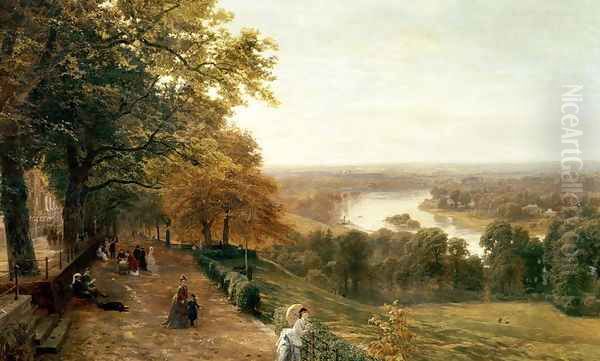
While perhaps less famous than The Pool of London, his numerous harvest scenes collectively represent a major aspect of his work and popularity. Titles like Ripening Sunbeams or simply Harvest Time capture the essence of these works. They are admired for their warm palettes, detailed rendering of crops and foliage, and the evocative depiction of late summer light bathing the landscape. These paintings perfectly encapsulated the Victorian ideal of the English countryside.
Other notable works further illustrate his range and preferred locations. Sandrock Bay, IW shows his ability to handle coastal scenery, depicting a location on the Isle of Wight. Paintings like Iffley Mill, near Oxford, demonstrate his interest in picturesque riverside architecture integrated into the landscape. His views of Windsor and Richmond Hill remain iconic representations of these famous Thames Valley landmarks, capturing the specific topography and atmosphere that made them popular destinations and subjects for artists.
Throughout his oeuvre, the consistent thread is Cole's commitment to capturing the specific character and mood of the English landscape. Whether depicting a quiet rural lane, a busy river scene, or a sun-drenched harvest field, his works convey a deep affection for his native scenery and a remarkable ability to translate its visual qualities into paint. His technical skill, combined with his accessible subject matter, ensured his enduring appeal.
Personal Life and Character
In 1857, George Vicat Cole married Mary Anne Chignell, the daughter of a Bond Street merchant. The marriage appears to have been a happy one, and the couple had three daughters: Mary Helen, Bertha, and Beatrice. The family provided a stable domestic background for his demanding artistic career. His success allowed them to live comfortably, eventually settling at Little Campden House on Campden Hill in Kensington, London, a substantial property with a studio.
The earlier conflict with his father, George Cole, in 1855 seems to have been resolved over time, although it marked a point of independence for the younger artist. Vicat Cole forged his own path, distinct from his father's, though both remained respected landscape painters. His own character was often described as genial and hardworking. His dedication to his craft was evident in the sheer volume and consistent quality of his output over four decades.
An anecdote sometimes recounted involves Cole withdrawing one of his own paintings from a prominent position ("on the line") at an exhibition to make way for the work of another artist whose painting had been poorly hung. While the specifics vary in tellings, such stories contributed to a reputation for generosity within the competitive art world of the time.
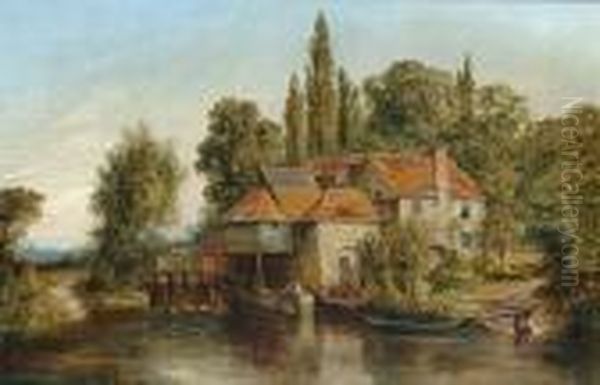
He remained active as a painter until the end of his life. George Vicat Cole passed away at his home, Little Campden House, on April 6, 1893, at the age of 59. He was buried in Kensal Green Cemetery. His death was widely reported, marking the loss of one of Britain's most popular artists.
Artistic Circle and Contemporaries
George Vicat Cole operated within a vibrant Victorian art world. His primary influence and teacher was his father, George Cole. He learned from and admired the great British landscape masters J.M.W. Turner and John Constable, as well as David Cox. His early career benefited from the encouragement of the prominent Pre-Raphaelite painter Sir John Everett Millais.
As a leading landscape painter, he was a contemporary of other successful artists working in similar genres. Benjamin Williams Leader (B.W. Leader) was perhaps his closest rival in terms of popularity, known for his picturesque views of Worcestershire and Wales, often featuring silver birch trees. While their styles differed, both catered to the strong public demand for accessible, naturalistic landscapes.
Other contemporaries included Alfred de Bréanski Sr., known for his dramatic depictions of the Scottish Highlands and Welsh mountains, offering a contrast to Cole's gentler southern scenes. Watercolourists like Myles Birket Foster and Helen Allingham specialized in detailed, often sentimental, depictions of rural life, cottages, and gardens, sharing Cole's focus on the charm of the English countryside, albeit in a different medium. Earlier landscape artists like John Linnell and Samuel Palmer, whose visionary intensity differed greatly from Cole's naturalism, still formed part of the broader tradition he inherited.
His artistic legacy extended directly through his family. His son, Rex Vicat Cole (1870–1940), also became a notable landscape painter and art teacher. Rex Vicat Cole carried on the family name in the art world and co-founded the Byam Shaw and Vicat Cole School of Art (later known as the Byam Shaw School of Art) with fellow artist John Byam Liston Shaw. This ensured the Vicat Cole name remained associated with art education well into the 20th century.
Legacy and Enduring Appeal
George Vicat Cole's legacy lies primarily in his contribution to the tradition of English landscape painting. During his lifetime, he was immensely popular, his works seen as embodying the idyllic beauty of the nation's countryside. He successfully captured a vision of rural England that resonated deeply with the Victorian public, offering a comforting counterpoint to the era's social and industrial changes.
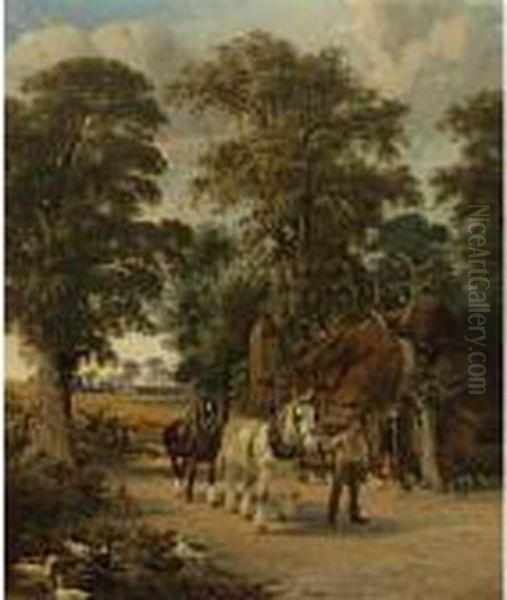
His influence can be seen in the continuation of naturalistic landscape painting into the late 19th and early 20th centuries. While Impressionism and Post-Impressionism were developing in France, Cole represented a more conservative but highly skilled and widely appreciated approach rooted in careful observation and traditional techniques. His focus on specific locations and atmospheric effects encouraged a detailed appreciation of Britain's regional landscapes.
The direct continuation of his artistic lineage through his son, Rex Vicat Cole, further cemented the family's contribution to British art. Rex not only painted landscapes but also authored important books on perspective and tree anatomy for artists, demonstrating a commitment to the technical foundations of art that likely reflected his father's training.
Today, George Vicat Cole's paintings are held in numerous public collections, including the Tate Britain, the Royal Academy of Arts, and many regional galleries throughout the UK. His works continue to be popular at auction, admired for their technical accomplishment, atmospheric beauty, and evocative portrayal of a bygone era of the English landscape. He remains a significant figure for understanding the tastes and artistic values of the Victorian period.
Conclusion
George Vicat Cole RA was a master of Victorian landscape painting. Through decades of dedicated work, he created an enduring visual record of the English countryside, particularly the gentle scenery of the Thames Valley, Surrey, and Sussex. His ability to capture the nuances of light and atmosphere, combined with his detailed yet accessible naturalism, earned him widespread acclaim during his lifetime. Influenced by his artist father and the great British landscape tradition, he forged a distinctive style that celebrated the tranquil beauty of his native land. While artistic fashions have changed, Cole's paintings retain their appeal, offering viewers meticulously crafted and deeply felt visions of England's pastoral heritage. His work stands as a testament to the enduring power of landscape art to evoke place, mood, and a connection to the natural world.